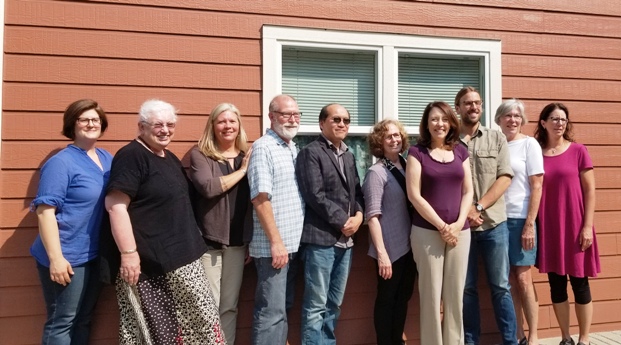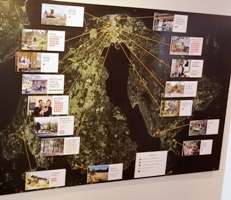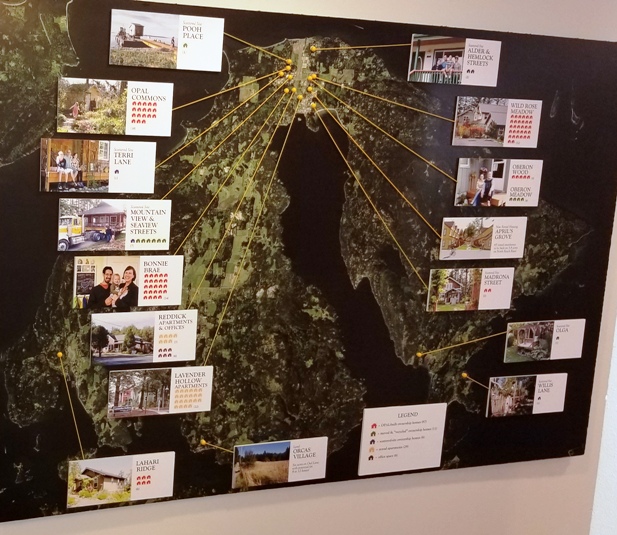— by Margie Doyle —

U.S. Senator Maria Cantwell (fourth from right) is flanked by OPAL staff, members and other community members concerned with affordable housing at a meeting in Eastsound on Friday, Aug. 10, 2018. Photo by Margie Doyle
U.S. Senator Maria Cantwell of Washington sat down to listen to San Juan County community organizers focused on affordable housing on Friday, Aug. 10, 2018.
She listened intently, asked perceptive questions,and offered hope and strategy for the affordable housing crisis affecting some 25 million American to the gathering of OPAL (Of People and the Land) Community Land Trust board and staff, local news publishers and County Affordable Housing Coordinator Ryan Page.
Cantwell said that upon entering the OPAL conference room on Enchanted Forest Road, “A man told me everything I needed to know in 30 seconds when he said, ‘I’ve been living on Orcas for a long time working, but living out of a tent. Because of OPAL, now I get to live here.'”
She finds on Orcas the new rural scenario resonates with what her Congressional counterparts in more conservative areas of the country such as the Midwest and Deep South may be finding, as the homeless numbers across the country increase from 15,000,000 to 25,000,000 in the last 10 years: the diversity of those seeking affordable housing; and the success of the tax credit program for affordable housing.
The “face” of affordable housing on Orcas includes seasonal workers crucial to a tourist economy; teachers and other government workers; medical, utilities, and other essential service workers.
Penny Sharp-Sky, a founder of OPAL Community Land Trust and an owner of one of its first homes in OPAL Commons on Seaview Street, spoke historically of the fear when OPAL was first starting that it might become like Nantucket Island on the east coast. In Nantucket, island employees had to commute to the island from the mainland, because they couldn’t afford housing costs on the island.
Now, she says that “Air BnB has stepped in, places that were available [for rent] aren’t so much anymore; people can pay their mortgage with [the revenues they get from ] air BnB in the summer.” And she and others noted that the “tourist season” has extended to the “shoulders” of summer months, in spring and fall.
“[Finding another place to live] is a very different thing than moving to the next community down the road,” Penny said. She spoke of two new businesses, owned by young entrepreneurs who are experiencing difficulty finding housing and said that this summer, OPAL Community Land Trust sold a house to “an established teacher who has moved every year for eight years.”
Ryan Page spoke of his own need for housing assurances before taking his job; he also mentioned the difficult-to-quantify stress of living year-to-year in a rental where “maybe the landlord will sell their place or turn it into a VRBO (vacation rental by owner).”
Pegi Groundwater, Chair of the OPAL Fundraising Committee, referred to the income/wealth/poverty disparity in the county: “We run into again and again the lack of commitment from local and state government for a rural community on an island that looks like it should be able to afford housing; but still needs major support from government.
“San Juan County is one of the wealthiest counties, but just the price of acquiring properties, of construction labor and materials on the island, have huge incremental costs. Employers have a hard time attracting labor.”
Page brought up that construction crews can make more money in Seattle, and “Developers only come out if you have at least 30 units to build.”
Tim Fuller, President of the OPAL Board of Trustees, said, “In OPAL’s fundraising, we’re trying to show the “faces” of affordable housing: servers at the restaurant, teachers, health care workers, emergency workers… all looking for housing. It’s one of the biggest issues in jobs here. The types of accommodations people make are incredible; most people are unaware of it.”
And new-comers to the community face the difficulty of not having those connections with island residents who have personally established relationships with potential housing providers. Groundwater spoke of local entrepreneurs who converted the Golden Tree Hostel into became housing for local workers, as an example of local employers who become landlords to support their business.
Some of these issues have been addressed, Cantwell said, by the state and federal tax credit programs for affordable housing, such as the award this spring of $4,312,702 in federal Low Income Housing Tax Credits (LIHTC) for OPAL’s new rental project, April’s Grove. Now OPAL is focused on raised the remaining $2M of the $12M project pricetag for this affordable housing project: https://theorcasonian.com/opal-nears-final-fundraising-goal-for-aprils-grove/.
April’s Grove on North Beach Road in Eastsound will provide 45 residences in 11 buildings, plus a commons building with laundry facilities and meeting room, play yard, and common garden and picnic area. When completed, rents will be based on percent of median income and will be affordable for households with annual incomes from $10,000 to $80,000.
Cantwell praised OPAL, saying “Their innovation that is allowable in this program is impressive.”
She spoke of the continuous work in persuading Congress of the value of the tax credit program for affordable housing.(https://www.wshfc.org/mhcf/9percent/index.htm ) It has been “unbelievably successful for housing and an economic stimulus for many different Americans — retiring seniors, returning veterans, and those workers with mental health and workplace issues.”
Though she had to defend legislation for the tax credit on a number of occasions before the congressional committee, since the passage of the affordable housing tax credit program, “a coalition of people came to us and asked for a 50% increase in capital dedicated to the affordable housing tax credit over 10 years.”
She lauded the work of other Senators on the program such as Orrin Hatch, R-Utah but also mentioned the challenges they face from their colleagues in the House of Representatives, who are “maybe not as up to speed or not as interested in solving the problem as we were. The Freedom caucus says no to everything. We have to explain to people that the investment is worth it. You’re not saving money by denying this investment.
“The facts are we have a decrease in supply and an increase in demand…how do you paint this picture? We need to paint various individuals about who this is for: homeless, seniors, veterans, mental health; all create demand.
“And the economic downturn [of 2008] took out people who had huge need. Now we’re back to an economy to grab the current [affordable housing] supply and turn it into marketplace rate.”
Cantwell said that people in Congress haven’t “fully absorbed [the challenge], perhaps because they’re misreading it, making assumptions. The tax credit thinking can be hard to understand,it’s not the easiest thing. And the Senate has a higher level of staff experience and longevity than the House.”
She said that Congress needs to see affordable housing projects and understand how they work in addressing the difficulties — “There are growing numbers of those who spend 50% of their income in housing. The problem is not going away, and without housing, we face increases in costs for health care and law enforcement. The research says it costs 25% more to deliver human services to the homeless.” She pointed out that the health insurance industry is making investments in affordable housing, “because they believe it’s an investment in health care.
“What lines do you draw? We definitely have to crack the nut with those who think they’re saving money by saying ‘no.’ That just makes everything more expensive. It’s no solution.”
Tim Fuller said that though people just don’t see the problem, awareness of the issue is starting to spread.”
Cantwell said that as she researches solutions such as OPAL that are meeting rural needs, and meets with colleagues that come from more rural states, she can present evidence that tax credits and other systemic approaches provide solutions for workforce housing.
“You guys are a bright light,” she told the OPAL roundtable.
(For more information about the April’s Grove project, or to contribute to fundraisng for that project, go to https://www.opalclt.org/in-the-works/new-rentals/)
**If you are reading theOrcasonian for free, thank your fellow islanders. If you would like to support theOrcasonian CLICK HERE to set your modestly-priced, voluntary subscription. Otherwise, no worries; we’re happy to share with you.**










Too bad they did not walk with the senator 50 yards up Enchanted Forest Road and show her the tent and trailer encampment in the woods.